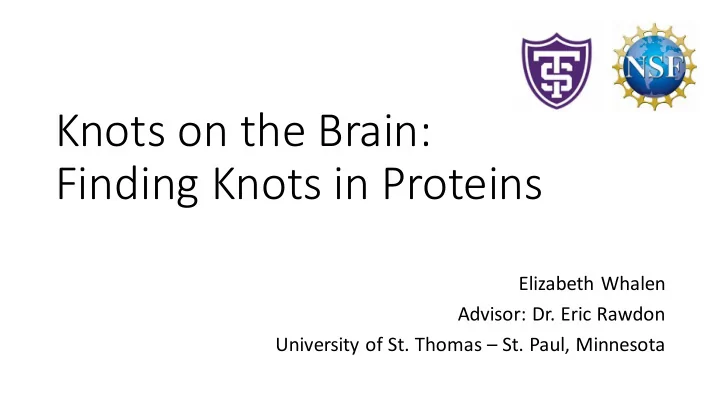

Knots on the Brain: Finding Knots in Proteins Elizabeth Whalen Advisor: Dr. Eric Rawdon University of St. Thomas – St. Paul, Minnesota
What is a mathematical knot? • A mathematical knot is a closed curve in 3-dimensional space, which can be visualized in 2D with a knot diagram • Open vs closed knots • Knots can be categorized by invariants like crossing number , or the smallest number of crossings in any diagram of the knot Figure eight (4 1 ) Knot
A larger crossing number generally means a more complicated knot: The 0 1 "unknot" The 3 1 "trefoil knot" 4 1 5 1 5 2 6 1 6 2 6 3
Knotted Proteins • Knots have been found in the backbones of some protein chains • For example, Ubiquitin C-terminal hydrolase L1 (UCH-L1): • Makes up 1-5% of total neuronal protein • UCH-L1 disfunction is linked to Alzheimer's Disease • One of the most complicated knotting structures found so far in proteins UCH-L1 knotted protein
????? Protein knots Protein function • Researchers believe that the location of the knots could provide critical information to understand this relationship
However... • The knots found in proteins are open knots • Traditional knot theory deals with closed knots • Next, characterize entanglement in open chains
Direct connection (easy but bad)
What if we shoot the endpoints out to infinity before connecting them?
Multiple directions
For any open chain: 1. Do this process in 100 different directions 2. Identify knot type for each direction 3. You get a distribution of knot types for the open chain 4. Highest proportion knot type
Location • The resulting knot type also varies depending on where on the protein you are doing this process • For each starting and ending amino acid number, there is an open knotted subchain • Trying to find connections between location and knotting
Example: protein 3BJX-A Starting amino acid number: 6, ending amino acid number: 310 Distribution: 6 1 : 0.68, 0 1 : 0.25, 3 1 : 0.03, 4 1 : 0.02, 5 2 : .02 Ending amino acid number Starting amino acid number
Protein UCH-L1 (2WE6-A)
An alternative way to classify • Frequently, the greatest proportion that resulted was the unknot, but this proportion was < 0.5 • Ex: 1 202 of UCH-L1: 0.1: 0.33, 3.1: 0.32, 5.2: 0.32, 5.1: 0.02, 7.3: 0.01 • Should we really be classifying these knots as unknots despite there being more "knotting" than "unknotting" going on?
Accumulation method example Protein 3BJX-A: Location: 1 290 • Original/proportional distribution: • 0 1 : 0.44 • 4 1 : 0.3 • 6 1 : 0.21 • 3 1 : 0.05 • Accumulation method: • 3 1 : 0.56 = 0.3 + 0.21 + 0.05 • 4 1 : 0.51 = 0.3 + 0.21 • 6 1 : 0.21
Protein 3BJX-A Location: 1 290 Original/proportional distribution: 0 1 : 0.44, 4 1 : 0.3, 6 1 : 0.21, 3 1 : 0.05 Accumulation method: 3 1 : 0.56 = 0.3 + 0.21 + 0.05, 4 1 : 0.51 = 0.3 + 0.21, 6 1 : 0.21 Proportion method Accumulation method
Protein UCH-L1 Proportion method Accumulation method
What these graphs tell us • What kind of knotting is happening at what location • New knot types appear with accumulation method • Frequent knotting locations • Grouping near axis • Center spot
Future Work • Do this for all proteins and compare/contrast • Develop a more complex "family tree" of relationships between knot types so we can better group the data for our accumulations
Acknowledgments • Dr. Eric Rawdon • Addie McCurdy • Brandon Tran • University of St. Thomas, St. Paul • National Science Foundation • KnotProt database • KnotPlot
Thank you!
Recommend
More recommend